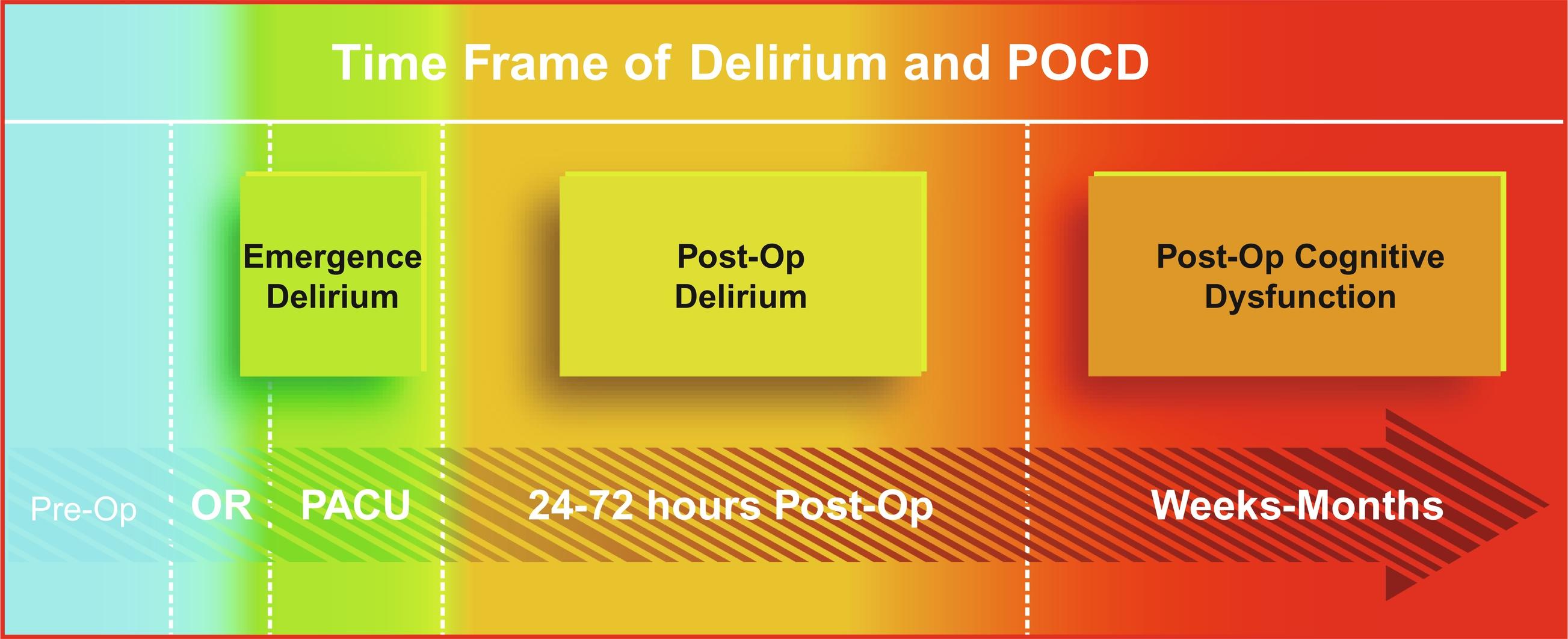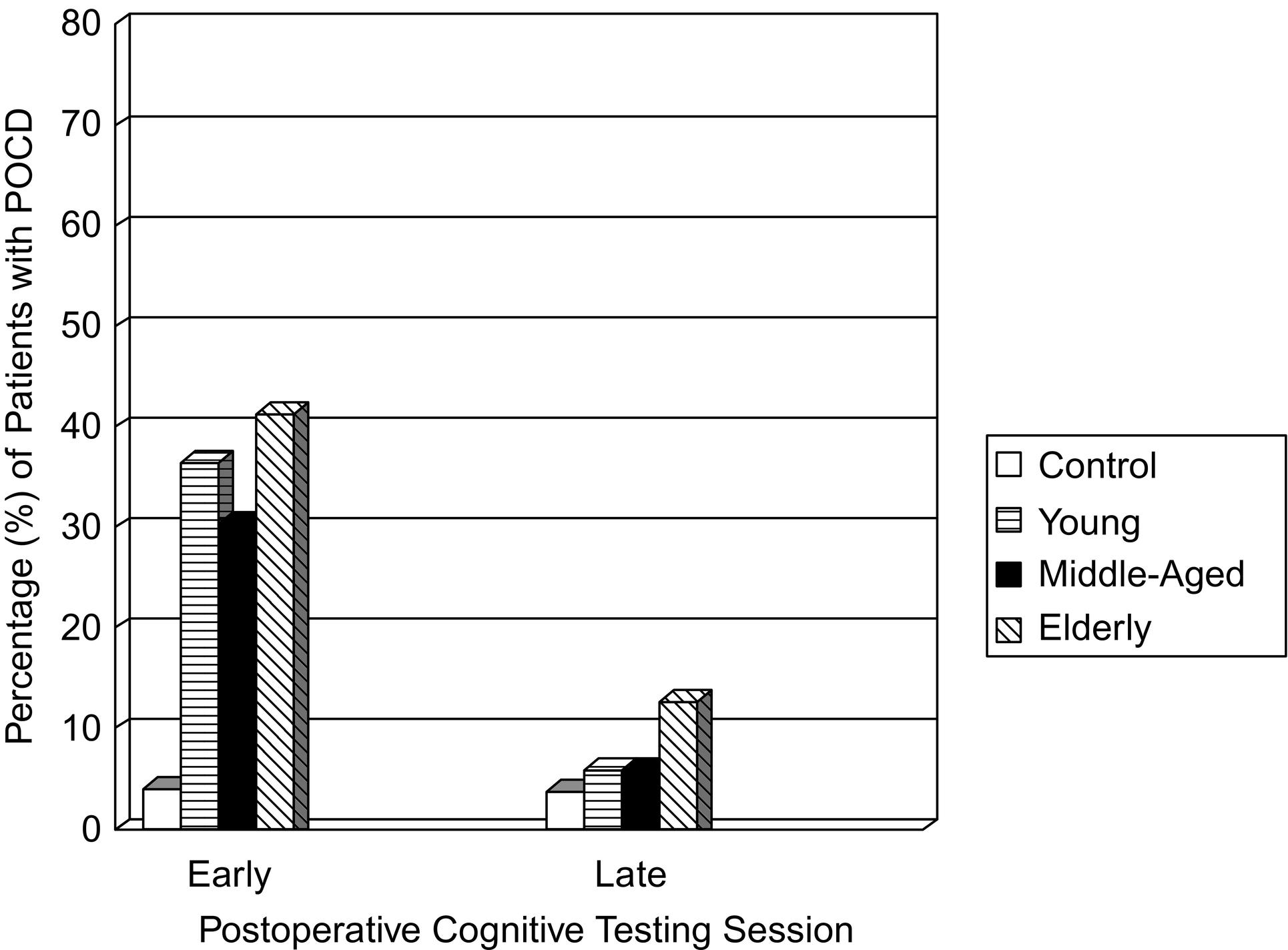Physical Address
304 North Cardinal St.
Dorchester Center, MA 02124
Since the inception of anesthesia changed and expanded surgery, some patients have experienced changes in cognitive function postoperatively. Elderly patients are at higher risk of these changes in neurocognitive function, probably because of reduced cognitive reserve and increased cerebral atherosclerosis. Changes in cognitive function are associated with impaired activities of daily living, which substantially reduce the quality of life in elderly patients. Various terms are used to describe changes in neurocognitive function after surgery, ranging from “postoperative delirium” (POD) to “postoperative cognitive dysfunction” (POCD) or “postoperative neurocognitive dysfunction” (POND). A recent publication from the Nomenclature Consensus Working Group recommends that “perioperative neurocognitive disorders” be used as an overarching term for cognitive impairment identified in the preoperative or postoperative period. This includes cognitive decline diagnosed before operation (described as neurocognitive disorder), any form of acute event (postoperative delirium), and cognitive decline diagnosed up to 30 days after the procedure (delayed neurocognitive recovery) and up to 12 months (postoperative neurocognitive disorder). For the purposes of this chapter, focused on postoperative complications, the term POCD is used to be consistent with the literature quoted. It is likely that the recommendations of the nomenclature working group will help more clearly define the timeline and incidence of POCD and delirium moving forward; however, several of the current authors have expressed concerns with the new recommendations.
The pathophysiologic mechanisms that underlie postoperative delirium and POCD are key to defining potential approaches to reduce their occurrence. Understanding the etiology of these perioperative changes is complicated by multiple factors. Clearly, anesthesia and surgery are rarely conducted separately, therefore it is difficult to disentangle their effects on cognition. Additionally, patients come to the operating room with different levels of comorbid illnesses that may affect cognition (such as cerebrovascular disease) and different levels of protective factors that may promote normal postoperative cognition (such as higher educational status). The combination of these procedural and patient factors define the key contributors to postoperative neurocognitive issues.
The safety of anesthesia and surgery has progressed over several decades to the point that elderly and debilitated patients may safely undergo increasingly complex procedures with low risk of major morbidity or mortality; however, this population is at increased risk of neurocognitive dysfunction. This chapter discusses cognitive changes that are often seen after anesthesia and surgery, how to determine which patients are at risk of postoperative delirium and/or cognitive dysfunction, and what clinicians can do to optimize postoperative cognition. The recent consensus statement discussed earlier has attempted to identify the clinical impact of cognitive impairment associated with the perioperative period. Those reviews redefine POCD in terms of geriatric medicine constructs so that the short-, medium-, and long-term clinical and functional impact can be better appreciated or anticipated.
Postoperative central nervous system (CNS) dysfunction includes emergence delirium, emergence agitation, POD, POCD, postoperative maladaptive behaviors, and postoperative stroke. These diagnoses share similar features but can be differentiated in part by their differential time courses ( Fig. 42.1 ). There is significant overlap in risk factors and suspected etiology between postoperative delirium and POCD, and delirium appears to affect the development of both early postoperative cognitive dysfunction and longer-term cognitive decline.

Delirium is a disturbance in attention and awareness that represents a change from baseline, accompanied by disturbed cognition, and not caused by a preexisting disorder or occurring in context of a severely reduced arousal level. Postoperative delirium rates range from 14% to greater than or equal to 50%, perhaps reflecting differing levels of delirium risk factors (e.g., older versus younger patients, and others). Delirium rates are likely underreported in routine clinical care.
Many studies have used preoperative and postoperative neuropsychologic testing to assess POCD after surgery, with varying testing deficit thresholds used to define POCD. POCD at 1 to 3 months after cardiac surgery and noncardiac surgery shows a wide range of reported incidence. Most studies show postoperative cognitive dysfunction rates decrease over time from 3 months to 1 year after surgery. A number of factors are important for interpreting these studies. First, with most neuropsychological testing, scores improve with repeat testing during short intervals (learning effect). These issues can be partly mitigated by including multiple individual tests to assess each cognitive domain and by using methods such as factor analysis to create overall cognitive domain scores. Thus, an optimal cognitive test battery includes assessments that span different cognitive domains and cognitive ability ranges. Also, postoperative cognitive changes in older adults occur superimposed on normal age-related neurocognitive/ neurophysiologic changes, including preexisting neurodegenerative pathology. Since Alzheimer’s disease-associated pathology begins decades prior to observable cognitive deficits (such as memory impairment), many older patients may have clinically silent Alzheimer’s disease-associated neuropathology; these patients are at increased risk of postoperative delirium and POCD. Many statistical or clinical thresholds have been used to define cognitive dysfunction after surgery. Some thresholds incorporate changes in one or two tests, some rely on changes in larger cognitive domains, such as attention and verbal memory, and others measure global change across an entire cognitive test battery. Depending on the statistical thresholds and rules used to define it, POCD may represent either a single-domain or multidomain deficit in memory, executive function, or other affected areas. It is unclear how long-term cognitive trajectories differ in more detailed domain specific (memory versus executive function) analysis. It is also important to consider the timing of preoperative and postoperative testing. Cognitive dysfunction early after surgery is likely to be influenced by postoperative pain, medications like opioids, and acute postoperative recovery. Global cognitive dysfunction 1 year after coronary artery bypass graft (CABG), for example, was directly correlated with worsened quality of life measures, and global cognitive dysfunction and worsened quality of life 1 year after CABG were associated with increased self-reported depressive symptoms (but not increased anxiety symptoms). A continued correlation between overall cognitive dysfunction and quality of life was also seen more than 5 years after cardiac surgery, with a similar association between both measures and self-reported depressive symptoms. This correlation between POCD and quality of life was present across the full range of cognitive dysfunction severity at 1 and 5 years after surgery; even relatively minor postoperative cognitive deficits were associated with reduced quality of life. Thus cognitive dysfunction should be considered a syndrome with a severity distribution. The idea that “subthreshold” postoperative cognitive deficits may be significant for patients is consistent with the emerging view in medicine that many disease processes represent a continuous spectrum rather than dichotomous traits.
POCD, an accepted complication of cardiac surgery, has been, until the last 20 years, less appreciated or defined after noncardiac surgery. In 1998, the International Study of Postoperative Cognitive Dysfunction (ISPOCD-1) evaluated cognitive decline in 1218 elderly patients who underwent major noncardiac surgery and found that cognitive dysfunction was present in 25% of patients 1 week after surgery and in 10% of patients 3 months after surgery.
To investigate further POCD after noncardiac surgery, Monk et al. completed a prospective assessment of 1064 patients undergoing elective noncardiac surgery. This assessment was divided among young (18–39 years of age), middle-aged (40–59 years of age), and elderly (60 years and older) patients. A group of 210 primary family members were used as controls to provide a change score similar to that used in the ISPOCD. The patients completed a battery of cognitive tests at baseline (preoperatively) and at both 1 week and 3 months postoperatively. Fig. 42.2 shows the incidence of POCD at the hospital discharge and 3-month postoperatively based on neuropsychological evaluations. At hospital discharge, the incidence of POCD was 36% in the young, 30.4% in the middle-aged, and 41.4% in the elderly patients. The incidence of cognitive decline was significantly lower in middle-aged patients compared with elderly patients ( P = 0.01), but was not different for young versus elderly or young versus middle-aged patients. The incidence of cognitive decline was similar for control subjects of all age groups at the first postoperative testing session: 4.1% in young, 2.8% in middle-aged, and 5.1% in elderly patients. However, the differences in cognitive decline between age-matched controls and patients were significant for all age groups ( P < 0.001). At 3 months after surgery, POCD was identified in 5.7% of young, 5.6% of middle-aged, and 12.7% of elderly patients. POCD was significantly higher in elderly compared to young or middle-aged patients ( P = 0.001). There was no difference in the incidence of POCD between age-matched control subjects and patients in the young and middle-aged groups. However, elderly patients exhibited a significantly greater incidence of cognitive decline at 3 months after surgery compared with elderly control subjects ( P < 0.001). Of the significant univariate predictive factors for POCD at 3 months after surgery, only increasing age, lower educational level, and POCD at hospital discharge remained significant in the multiple logistic regression analysis. The results of this trial indicate that postoperative cognitive dysfunction is common in all age groups at 1 week. However, at 3 months after surgery it is more common in the elderly with lower educational achievement. Monk et al. not only reported on the incidence of POCD, but also reevaluated patients at 1 year to collect mortality data. They found an increase in 3-month mortality associated with POCD at discharge compared with those without POCD at discharge ( P = 0.02). They also found that patients with POCD at both discharge and 3 months have a significantly higher 1-year mortality rate than any other group ( Fig. 42.3 ).

![Fig. 42.3, Relation between the presence of postoperative cognitive dysfunction (POCD) and the percentage of patients who died in the first year after surgery. This figure includes only patients who survived to test at the 3-month (late) test time. The figure includes the following four groups: none (patients who did not experience POCD at either of the testing times), hospital discharge (patients who had POCD only at hospital discharge), 3 months (patients who had POCD only at the late [3 months postoperative] testing session), and hospital discharge + 3 months (patients who had POCD at both hospital discharge and the late testing sessions). Hospital discharge + 3 months group was significantly different from the other 3 groups, P =0.02*. Fig. 42.3, Relation between the presence of postoperative cognitive dysfunction (POCD) and the percentage of patients who died in the first year after surgery. This figure includes only patients who survived to test at the 3-month (late) test time. The figure includes the following four groups: none (patients who did not experience POCD at either of the testing times), hospital discharge (patients who had POCD only at hospital discharge), 3 months (patients who had POCD only at the late [3 months postoperative] testing session), and hospital discharge + 3 months (patients who had POCD at both hospital discharge and the late testing sessions). Hospital discharge + 3 months group was significantly different from the other 3 groups, P =0.02*.](https://storage.googleapis.com/dl.dentistrykey.com/clinical/PostoperativeCognitiveDysfunctionandDelirium/2_3s20B9780323567244000423.jpg)
Become a Clinical Tree membership for Full access and enjoy Unlimited articles
If you are a member. Log in here